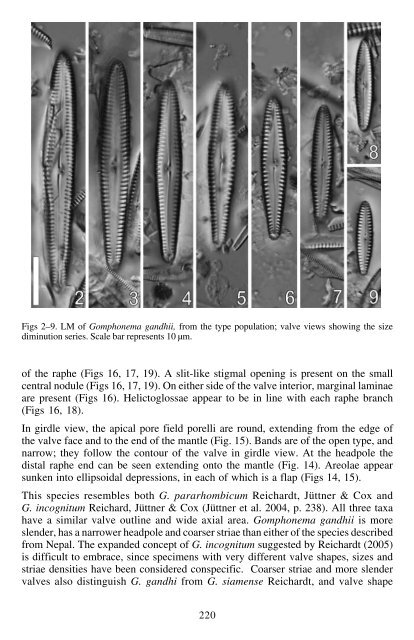The diatom genus Gomphonema Ehrenberg in India: Checklist and ...
The diatom genus Gomphonema Ehrenberg in India: Checklist and ... The diatom genus Gomphonema Ehrenberg in India: Checklist and ...
Figs 2–9. LM of Gomphonema gandhii, from the type population; valve views showing the size diminution series. Scale bar represents 10 µm. of the raphe (Figs 16, 17, 19). A slit-like stigmal opening is present on the small central nodule (Figs 16, 17, 19). On either side of the valve interior, marginal laminae are present (Figs 16). Helictoglossae appear to be in line with each raphe branch (Figs 16, 18). In girdle view, the apical pore field porelli are round, extending from the edge of the valve face and to the end of the mantle (Fig. 15). Bands are of the open type, and narrow; they follow the contour of the valve in girdle view. At the headpole the distal raphe end can be seen extending onto the mantle (Fig. 14). Areolae appear sunken into ellipsoidal depressions, in each of which is a flap (Figs 14, 15). This species resembles both G. pararhombicum Reichardt, Jüttner & Cox and G. incognitum Reichard, Jüttner & Cox (Jüttner et al. 2004, p. 238). All three taxa have a similar valve outline and wide axial area. Gomphonema gandhii is more slender, has a narrower headpole and coarser striae than either of the species described from Nepal. The expanded concept of G. incognitum suggested by Reichardt (2005) is difficult to embrace, since specimens with very different valve shapes, sizes and striae densities have been considered conspecific. Coarser striae and more slender valves also distinguish G. gandhi from G. siamense Reichardt, and valve shape 220
Figs 10–15. SEM. External view of Gomphonema gandhii. Fig. 10. Exterior view of whole valve. Fig. 11. Exterior of valve, headpole, with the external distal raphe end curving onto the valve mantle. Fig. 12. Exterior of valve center showing the stigma, dilated proximal raphe end and striae. Fig. 13. Exterior of valve showing the deflected apical end of raphe and rounded porelli. Fig. 14. Girdle view of the head pole showing the distal raphe end extending on to the mantle. Fig. 15 Girdle view of the foot pole with round apical pore field porelli. Scale bar represents 5µm (Fig. 10); 1 µm (Figs 11, 12, 13, 14, 15). 221
- Page 1 and 2: Nova Hedwigia Vol. 93 issue 1-2, 21
- Page 3 and 4: Fig 1. Map showing the area of inve
- Page 5 and 6: 28 Gomphonema clevei v. bipunctata
- Page 7 and 8: 82 Gomphonema magnifica Gandhi v. G
- Page 9: Naphrax mounting medium and observe
- Page 13 and 14: Table 2. Water Chemistry Characteri
- Page 15 and 16: Figs 34-36. SEM. External view of G
- Page 17 and 18: one positioned at the headpole is u
- Page 19 and 20: Figs 47-51. SEM. Exterior, Interior
- Page 21 and 22: many students of the genus Gomphone
- Page 23 and 24: GANDHI, H.P. (1959b): Freshwater di
- Page 25 and 26: METZELTIN, D. & H. LANGE-BERTALOT (
Figs 2–9. LM of <strong>Gomphonema</strong> g<strong>and</strong>hii, from the type population; valve views show<strong>in</strong>g the size<br />
dim<strong>in</strong>ution series. Scale bar represents 10 µm.<br />
of the raphe (Figs 16, 17, 19). A slit-like stigmal open<strong>in</strong>g is present on the small<br />
central nodule (Figs 16, 17, 19). On either side of the valve <strong>in</strong>terior, marg<strong>in</strong>al lam<strong>in</strong>ae<br />
are present (Figs 16). Helictoglossae appear to be <strong>in</strong> l<strong>in</strong>e with each raphe branch<br />
(Figs 16, 18).<br />
In girdle view, the apical pore field porelli are round, extend<strong>in</strong>g from the edge of<br />
the valve face <strong>and</strong> to the end of the mantle (Fig. 15). B<strong>and</strong>s are of the open type, <strong>and</strong><br />
narrow; they follow the contour of the valve <strong>in</strong> girdle view. At the headpole the<br />
distal raphe end can be seen extend<strong>in</strong>g onto the mantle (Fig. 14). Areolae appear<br />
sunken <strong>in</strong>to ellipsoidal depressions, <strong>in</strong> each of which is a flap (Figs 14, 15).<br />
This species resembles both G. pararhombicum Reichardt, Jüttner & Cox <strong>and</strong><br />
G. <strong>in</strong>cognitum Reichard, Jüttner & Cox (Jüttner et al. 2004, p. 238). All three taxa<br />
have a similar valve outl<strong>in</strong>e <strong>and</strong> wide axial area. <strong>Gomphonema</strong> g<strong>and</strong>hii is more<br />
slender, has a narrower headpole <strong>and</strong> coarser striae than either of the species described<br />
from Nepal. <strong>The</strong> exp<strong>and</strong>ed concept of G. <strong>in</strong>cognitum suggested by Reichardt (2005)<br />
is difficult to embrace, s<strong>in</strong>ce specimens with very different valve shapes, sizes <strong>and</strong><br />
striae densities have been considered conspecific. Coarser striae <strong>and</strong> more slender<br />
valves also dist<strong>in</strong>guish G. g<strong>and</strong>hi from G. siamense Reichardt, <strong>and</strong> valve shape<br />
220



